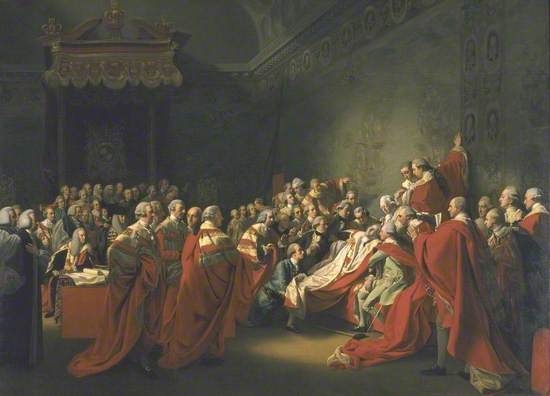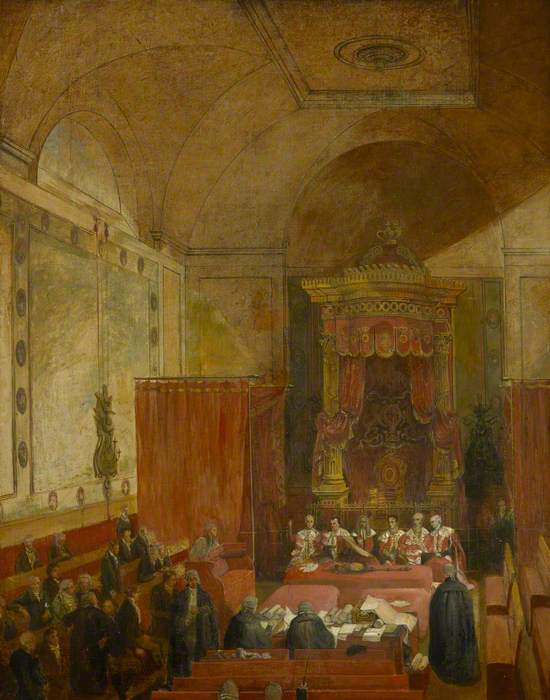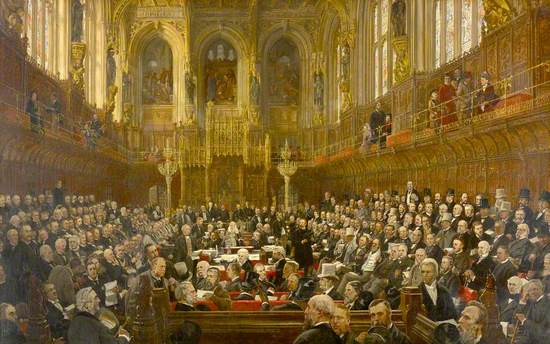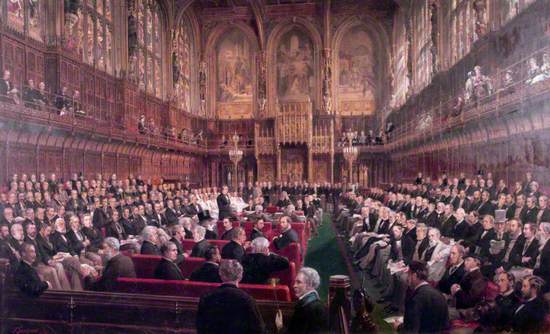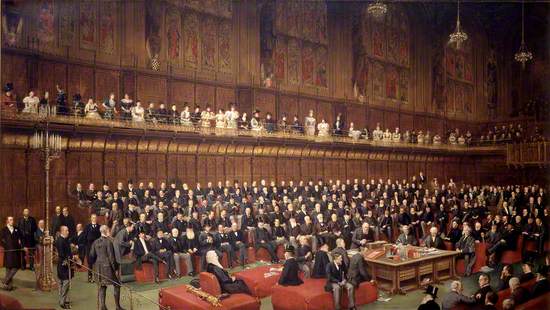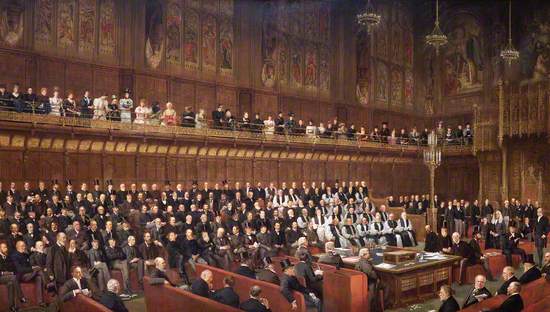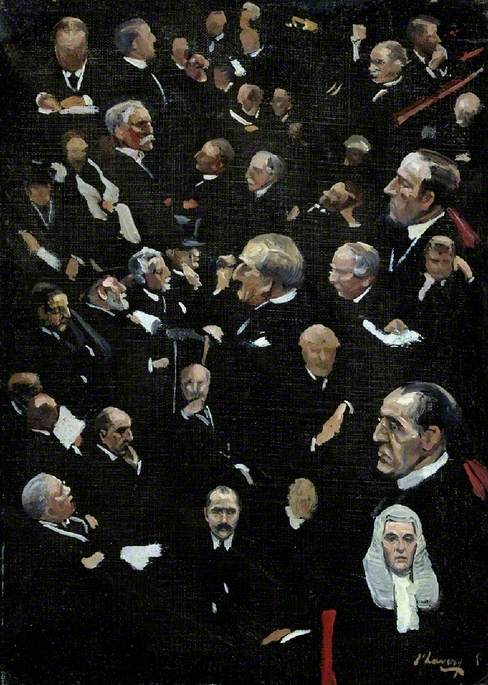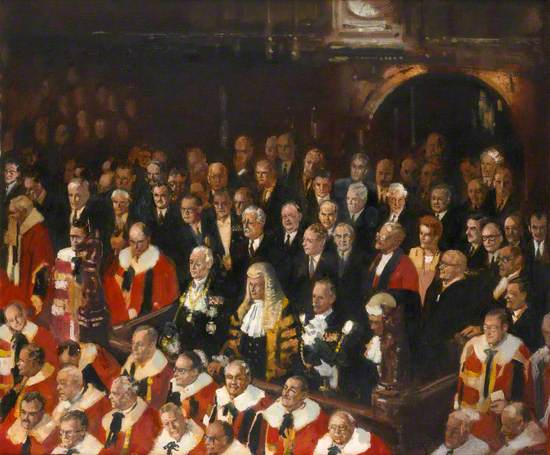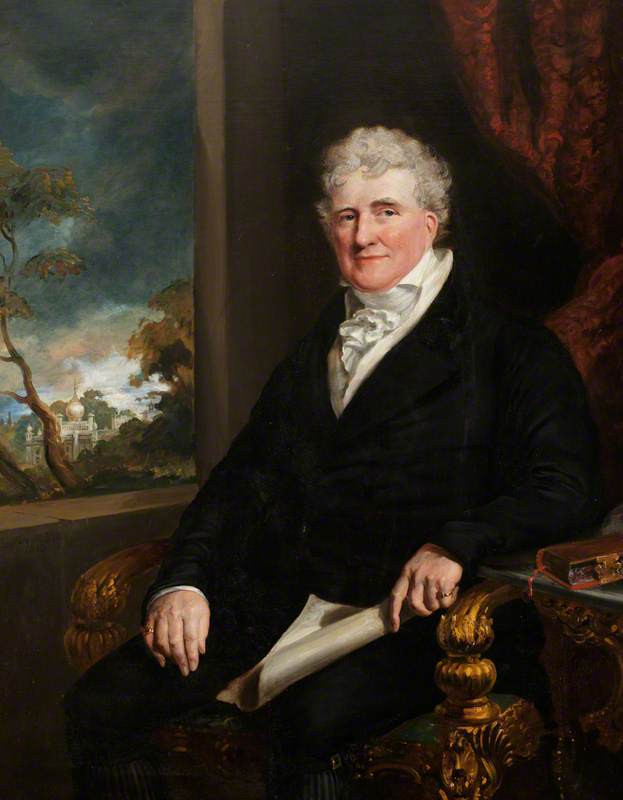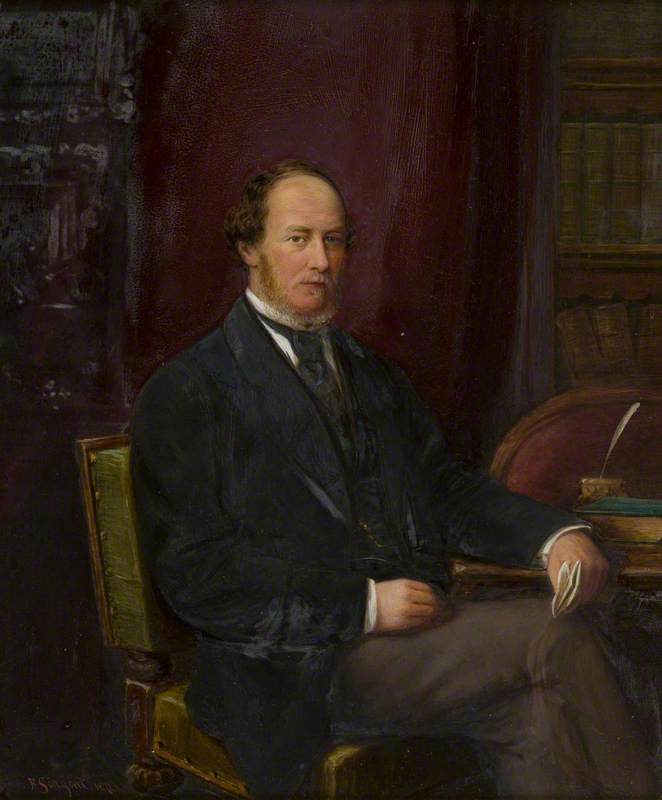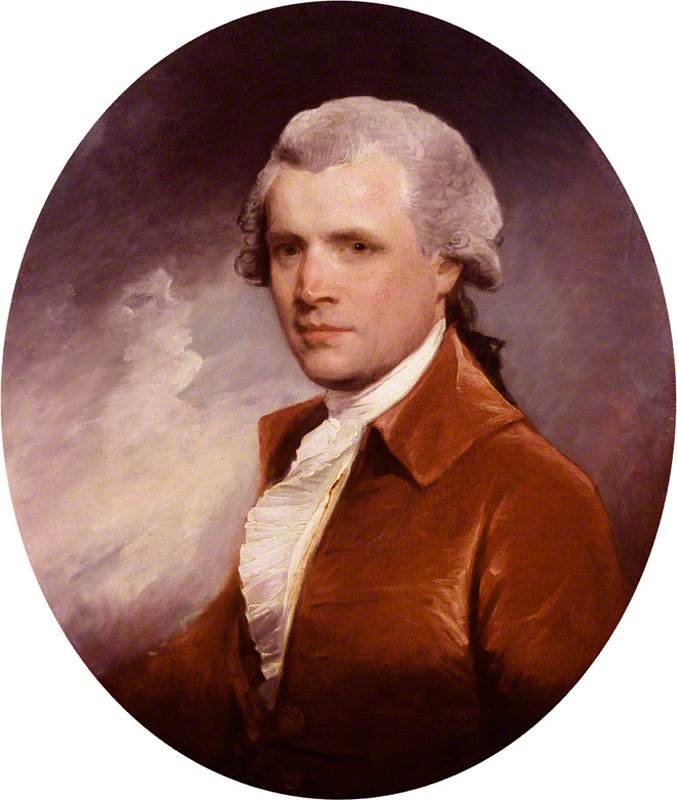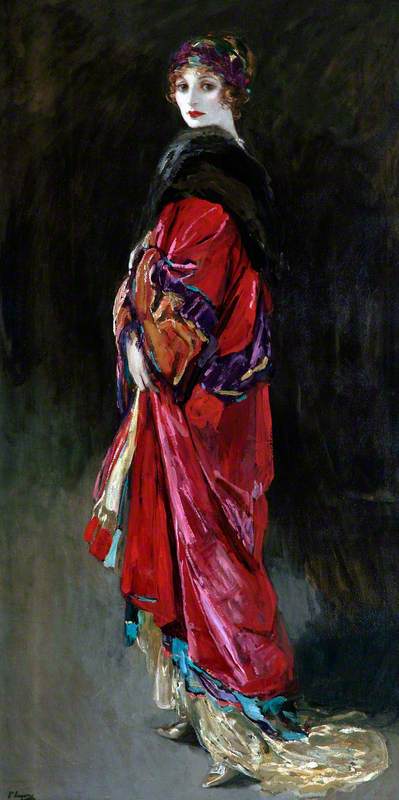The most striking difference between the chambers of the Commons and the Lords is colour. The Commons chamber is all dull browns and greens; the Lords is visually a bit of a riot, with reds and yellows and blues, gilding, stained glass and bronze statues. It hasn't always been true, for the chamber before the Union with Ireland in 1800 was more dowdy (the sixteenth-century Armada tapestries, fine though they were, must have been predominantly dim greens and blues), and extremely dingy. Painters have not always taken full advantage, for there are probably even more dull paintings of the Lords than there are of the Commons. There are, though, some highlights too. This is a sample, mostly, of the better ones
The Collapse of the Earl of Chatham in the House of Lords, 7 July 1778
Copley's picture records an incident on 7 April 1778 at the height of the American War of independence. The old and infirm Earl of Chatham (better known as Pitt the Elder) had made a passionate speech opposing the withdrawal of British troops and the abandonment of America; shortly afterwards he suffered a stroke and collapsed. He died about six weeks later. Copley put his peers in their robes presumably to cheer up the rather gloomy chamber of the Lords. But the light that falls on Chatham also illuminates the tapestries that celebrate the defeat of the Spanish Armada nearly two hundred years before, and emphasise the importance of Britain's naval power just as a new attack, from Spain and France, was anxiously anticipated.
John Singleton Copley (1738–1815)
Oil on canvas
H 228.6 x W 307.3 cm
Tate
The Trial of Queen Caroline 1820
The so-called 'Trial' of George IV's spouse, Queen Caroline, was in fact the proceedings on the bill 'of pains and penalties' which was supposed to enable the king to divorce her. The Whig opposition sought to build on popular disapproval of the king's attempts to get rid of his wife to create a huge political crisis for the Tory government. George Hayter's painting was made for the Whig politician George Agar Ellis (he is shown standing immediately below the balcony at the bottom right; Hayter himself is behind him, holding a portfolio). It shows the chamber into which the House of Lords moved on the Union with Ireland in 1800, the old Court of Requests, adapted by Sir John Soane with its huge new windows.
George Hayter (1792–1871)
Oil on canvas
H 233 x W 356.2 cm
National Portrait Gallery, London
Passing the Reform Bill, 1832, Interior of Court of Requests
This is a sketch for a painting, followed up by a mezzotint, to celebrate the eventual passage of the Reform Act in 1832 that began to transform the nature of representation in Britain. The commissioners who formally pronounce royal assent to the act are lined up in their robes on a bench in front of the throne; the clerks are at their table; a number of peers on the government side have come to see the bill through. The benches usually occupied by the opposition - which had bitterly fought against the bill - are empty. Reynolds's great patron was the radical MP Samuel Whitbread and he seems to have imbibed some of that radicalism, which would explain this picture. The chamber as the same as in Hayter's, but with the galleries removed.
Samuel William Reynolds the elder (1773–1835)
Oil on canvas
H 65.8 x W 53.2 cm
Parliamentary Art Collection
The House of Lords by William Morrison Wyllie
Wyllie's painting shows the chamber built by Sir Charles Barry as part of the palace that replace the old complex that was destroyed by fire in 1834. The painting is the companion to Wyllie's earlier (1878) picture of the House of Commons. Like the Commons picture, it was published commercially, with a key to the identity of the sitters. The Commons picture is much better, with much more of a sense of drama about it, and a much greater sense of the idiosyncracy of individual sitters. Still, Wyllie's interest in light effects and big skies is perhaps reflected in the unusually strong sunlight coming through the windows. As with the Commons picture, the proliferation of light-coloured top hats indicates that this is high summer.
William Morrison Wyllie (c.1820–1895)
Oil on canvas
H 104.1 x W 167.6 cm
Parliamentary Art Collection
House of Lords, 1880
In an article in the Graphic in 1884 this picture is called 'The closing scene in the life of Benjamin Disraeli, Earl of Beaconsfield KG'. Disraeli is at its centre, addressing the House. 'Nearly every one of the 250 portraits depicted including that of the prince of Wales', The Graphic said, 'has been completed from special sittings given to Mr Sargent, who had one of the committee rooms in the house of lords placed at his disposal during the progress of the picture.' The picture probably represents Disraeli's last significant speech to the Lords on 3 March 1881, on the withdrawal of British troops from Afghanistan. He died around six weeks later.
Frederick Sargent (1837–1899)
Oil on paper
H 83.9 x W 134.7 cm
Parliamentary Art Collection
The Home Rule Debate in House of Lords, 1893, Gladstone's Second Bill Rejected, Marquess of Salisbury Speaking
This painting is one of a pair (see next item) depicting the great debate on the 1893 Home Rule bill in the House of Lords. After a debate of four days, the Lords rejected by 419 votes to 41 the central policy of Gladstone's government elected the year before. The report in The Times conveyed the excitement and tension of the occasion, with all of the galleries full with MPs and the public, and the 'peeresses' galleries on either side of the house were brilliant with the colours of many bright costumes. The long stretch of empty red benches which the floor of the House usually presents to the eye was not visible today'. The paintings probably represent the final day of the debate, Friday 8 September, when the vote was taken.
Dickinson (active 1890–1910) and Foster (active 1890–1910)
Oil on canvas
H 205.8 x W 365.8 cm
Parliamentary Art Collection
The Home Rule Debate in House of Lords, 1893, Lord Chancellor about to Put the Question
Although many of the details of the Times's report are recognisable in this pair of pictures, they convey little animation or excitement. Dickinson and Foster were a firm based in Bond Street specialising mainly in society portrait photography. But they had a sideline in creating enormous paintings of sporting events (usually equestrian, or sometimes cricketing) with individual portraits of the participants, paid for by subscription. The technique is here translated to the House of Lords. According to one newspaper report, the pictures were created by a 'corps of painters' employed by the firm, based on individual portraits 'taken either directly from life or through a photographic medium'. It looks like it.
Dickinson (active 1890–1910) and Foster (active 1890–1910)
Oil on canvas
H 205.8 x W 365.8 cm
Parliamentary Art Collection
Viscount Morley Addressing the House of Lords
In Lavery's memoir this picture is titled 'Viscount Morley moving the address on the Irish Treaty in the House of Lords, 1922'. In fact this was the debate on the address in reply to the King's speech on 14 December 1921. The Anglo-Irish treaty had been signed about a week before, bringing an end to the insurgency and making the Irish Free State into one of the self-governing dominions of the Empire. The precise subject no doubt reflects Lavery's long-term support for Irish independence, although he writes that it was painted at the suggestion of Lord Birkenhead, the lord chancellor, who had been closely involved in the negotiations. The picture pre-dates its companion painting of the Commons.
John Lavery (1856–1941)
Oil on canvas
H 127 x W 101.6 cm
Glasgow Life Museums
Studies Made in the House of Lords
Lavery wrote that when working on his House of Lords picture 'I was permitted to work in the Press Gallery looking down on their Lordships, not on a level with them as in the House of Commons'; the journalists in the gallery helped him to identify individual members. Being in the press gallery explains the rather higher perspective of his House of Lords picture than the Commons one, which was taken from the benches underneath the gallery.When the picture was finished and on exhibition at the Royal Academy there was talk of purchasing it for the House of Lords, 'but it turned out to be only talk'. Since his House of Commons picture had been bought by Glasgow corporation, he gave the Lords one to the city as well.
John Lavery (1856–1941)
Oil on canvas
H 30.6 x W 25.4 cm
The Fitzwilliam Museum
State Opening of Parliament, House of Lords, 1960
I think I like this one best. Gilroy was extremely well-known as an illustrator, particularly as a designer of advertising posters: his images for Guinness in the 1930s and 1940s (think of Toucans) are justly famous for their wit and sharp design. All of that is evident in this picture with its quirky angle, from the side galleries, and focus on the attendees from the Commons, rather than the more predictable emphasis on the Queen sitting on the throne. And for once, while there are some recognisable figures (Harold Macmillan and Hugh Gaitskell for example, and that's probably Barbara Castle), no attempt has been made to create a tiresome series of individual portraits.
John Thomas Young Gilroy (1898–1985)
Oil on canvas
H 86.4 x W 98.5 cm
Parliamentary Art Collection
